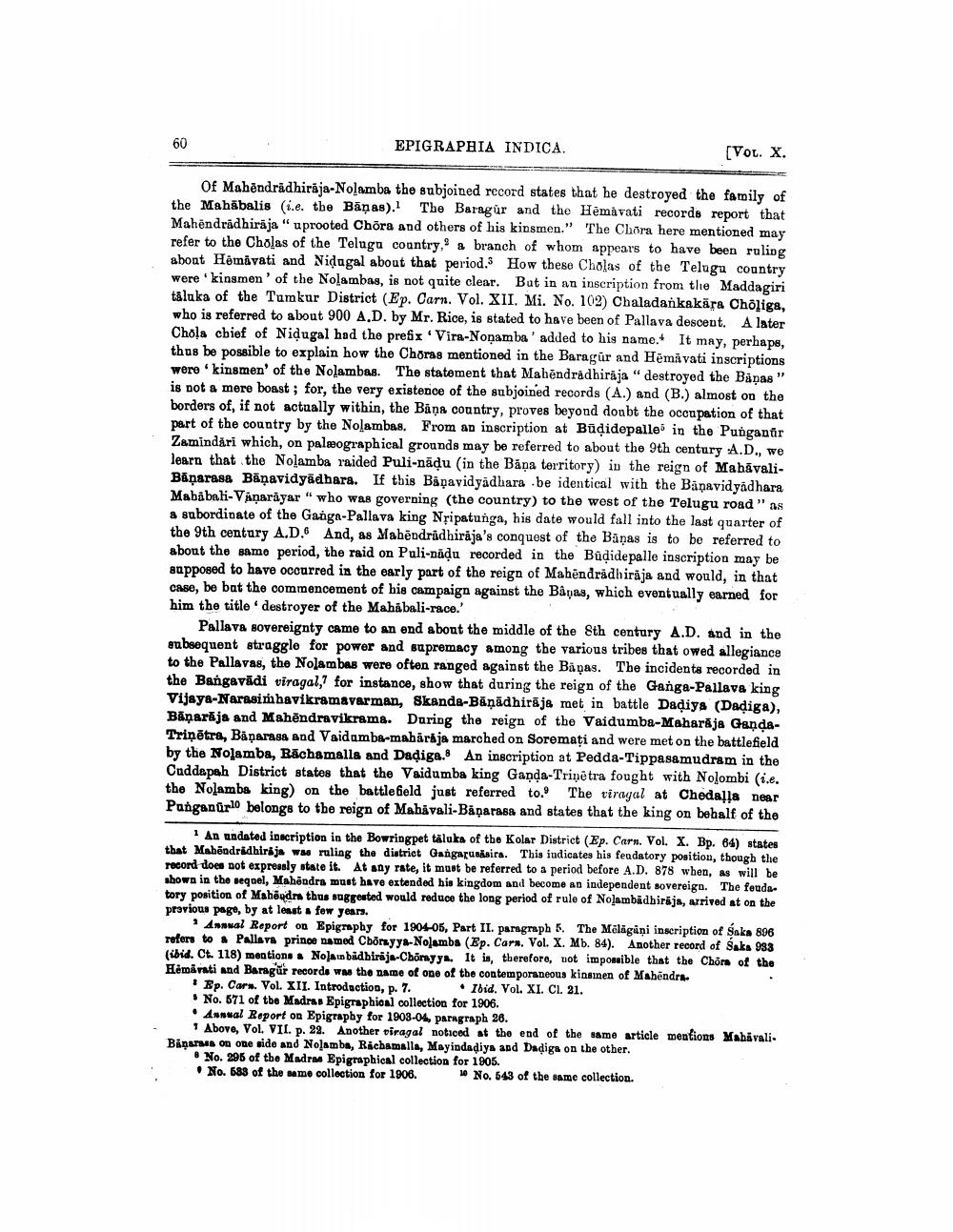________________
EPIGRAPHIA INDICA.
(Vou. X.
Of Mahendrädhiraja-Nolamba the subjoined record states that he destroyed the family of the Mahabalis (i.e. the Bāņas). The Baragür and the Hemavati recordo report that Mahendradhiraja" uprooted Chöra and others of his kinsmen." The Chöra here mentioned may refer to the Cholas of the Teluga country, a branch of whom appears to have been ruling about Hémivati and Nidagal about that period. How these Cholas of the Telugu country were 'kinsmen of the Nolambas, is not quite clear. But in an inscription from the Maddagiri täluka of the Tumkur District (Ep. Carn. Vol. XII. Mi. No. 102) Chaladankakära Choliga, who is referred to about 900 A.D. by Mr. Rice, is stated to have been of Pallava descent. A later Chola chief of Nidugal had the prefix Vira-Noņamba' added to his name. It may, perhaps, thus be possible to explain how the Choras mentioned in the Baragür and Hemavati inscriptions were kinsmen of the Nolambas. The statement that Mahendradhiraja "destroyed the Baņas " is not a mere boast; for, the very existence of the subjoined records (A.) and (B.) almost on the borders of, if not actually within, the Bana country, proves beyond doubt the occupation of that part of the country by the Nolambas. From an inscription at Būdidepalle in the Punganar Zamindări which, on palæographical grounds may be referred to about the 9th century A.D., we learn that the Nolamba raided Puli-nādu (in the Bapa territory) in the reign of MabávaliBanarasa Bāņavidyādbara. If this Baņavidyadhara .be identical with the Banavidyadhara Mababali-Vanarayar" who was governing (the country) to the west of the Telugu road "as a subordinate of the Ganga-Pallava king Nripatunga, his date would fall into the last quarter of the 9th century A.D. And, as Mahendradhiraja's conquest of the Banas is to be referred to about the same period, the raid on Poli-nádu recorded in the Budidepalle inscription may be supposed to have occurred in the early part of the reign of Mahendrădhiraja and would, in that case, be bat the commencement of his campaign against the Baras, which eventually earned for him the title destroyer of the Mahabali-race.'
Pallava sovereignty came to an end about the middle of the Sth century A.D. and in the subsequent straggle for power and sapremacy among the various tribes that owed allegiance to the Pallavas, the Nolambas were often ranged against the Baņas. The incidents recorded in the Bangavādi viragal, for instance, show that during the reign of the Ganga-Pallava king Vijaya-Narasimhavikramavarman, Skanda-Baņādhirajs met in battle Dadiya (Dadiga), Bāņarāja and Mahendravikrama. During the reign of the Vaidumba-Maharāja GandaTrinētra, Banarasa and Vaidamba-maharaja marched on Soremați and were met on the battlefield by the Nolamba, Rāchamalla and Dadiga. An inscription at Pedda-Tippasamudram in the Caddepah District states that the Vaidumba king Ganda-Trinētra fought with Nolombi (i.e. the Nolamba king) on the battlefield just referred to. The tirayal at Chedaļls near Panganürlo belongs to the reign of Mahåvali-Banarasa and states that the king on behalf of the
An undated inscription in the Bowringpet täluks of the Kolar District (Ep. Carn. Vol. X. Bp. 84) states that Mahondridhiraja was ruling the district Gangarusasira. This indicates his feudatory position, though the record does not expressly stato it. At any rate, it must be referred to a period before A.D. 878 when, as will be shown in the sequel, Mahendra must have extended his kingdom and become an independent sovereign. The feudatory position of Mahoods thus suggested would reduce the long period of rule of Nolambadhirijs, arrived at on the previous page, by at least a few years.
Annual Report on Epigraphy for 1904-05, Part II. paragraph & The Mēlägiņi inscription of Şaka 896 refers to . Pallava prince named Cborayya-Nolamba (Ep. Cars, Vol. X. Mb. 84). Another record of Saks 933 (ibid. Ct. 118) meations Nolain badhiraja-Chöryys. It is, therefore, not impossible that the Chor of the Hémarati and Baragür records was the name of one of the contemporaneous kinsinen of Mahendre
Ep. Cars. Vol. XII. Introdaction, p. 7. • Ibid. VOL. XI. Cl. 31. • No. 671 of the Madras Epigraphioal collection for 1906. • Assual Report on Epigraphy for 1908-04, paragraph 26.
Above, Vol. VII. p. 22. Another viragal noticed at the end of the same article mentions Mahávali. Binarssa on one side and Nolamba, Rachamalla, Mayindadiya and Dadiga on the other.
• No. 295 of the Madro Epigraphical collection for 1905.
No. 683 of the same collection for 1906. No. 543 of the same collection.




